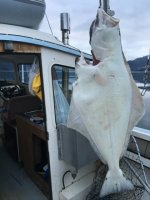I'm not a certified downrigger engineer, but I did stay in a Holiday Inn Express last night.
Braid vs wire: braid all way if you're fishing salt water at any appreciable depth. Less blow back from thinner diameter and no worry of salt corrosion. Cable probably lasts forever in WI fishing freshwater. I wrap the inside of my spool with duct tape to mitigate the chance of it splitting from the braid digging into itself. (Hint: to keep braid from digging into itself, quit hanging your ball up on the bottom.) Speaking of hanging up on the bottom, if you set the clutch correctly, you don't need to have super high test braid. I think mine is 175 lbs. I also use a shock-bungy to connect the ball so the newbies that stop it too quickly on decent don't snap it off.
Downrigger boom length: I used to have the short 24" booms. They're fine if you're fishing in flat water and pay attention when you turn. Keep the kicker on the inside of your turns and you'll never have a problem. But, if you fish in strong cross currents or slip down the face of a swell, you'll eventually run that 'rigger line into the kicker prop. I've lost two balls that way. Two remedies--prop guard as mentioned, and longer booms. Scotty booms are just shy of $100 each. Well worth it, IMHO, especially if you're fishing divers off the stern at the same time; you get a wider spread and fish more water.
Bottom tracking downriggers: Gimmick. Waste o' money. If they were necessary, Scotty would make them. 8) Seriously, they have a purpose if you're fishing winter blackmouth in the Sound. Those fish are real bottom huggers and won't come up to chase bait. However, if you fish the ocean or a body of water in excess of, say, 200', you're more than likely trolling for suspended fish in the 60-180' water column. Even halibut will come 20-30' off the bottom to chase bait, so I don't think they're necessary for 'buts, either. The other problem I have with those bottom trackers is how it affects the tension on your rod. Let's say your tracking 5' off the bottom in 100 FOW. You then go over a 30' trench and the downrigger lowers the ball like it's supposed to. Will the fishing line stay in the clip or release? My bet is it will release from the extra tension. What about the opposite when the sea floor comes up 40'? The downrigger brings the ball up, and now you have too much slack in your fishing line. Just not my thing.
Another tip: If you have Scottys, use about a 10' length of tuna cord between the braid and the ball. Use a large SS swivel to connect the two lines. The swivel will act as a 'stop' when the ball's at the surface. You won't have to worry about those plastic stops slipping on the braid.

